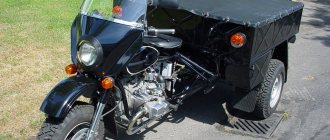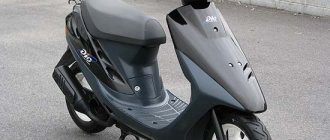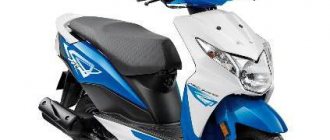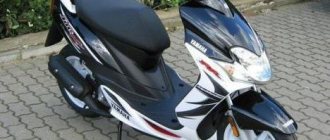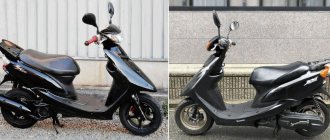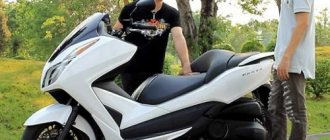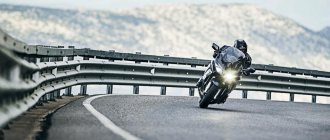Judging by the new scooter models appearing on the roads, the well-being of people in Thailand growing. More and more fashionable and heavier models of motorbikes are appearing on sale. This is also beneficial for tourists - you can ride on various interesting machines for little money.
Just recently I wrote a review about renting a Honda “Forza” motorbike. This large scooter impressed me and this year I didn’t expect anything more interesting. However, in Thailand, life does not stand still. The other day I accidentally came across a new foppish model from Yamaha. Well, I couldn’t resist - I rented a new and unusual three-wheeled Yamaha “TriCity” scooter .
So, I offer my review of this interesting motorbike.
In the photo: Yamaha “Tri-City” is still a very bulky scooter
The three-wheeled Yamaha TriCity scooter, with dimensions comparable to the Honda PCX, is equipped with a 125 hp engine. The motorbike has a bright and memorable design, but its purpose is unclear. The massive front part of the body causes strange sensations when driving along narrow Thai streets.
In the photo: the Yamaha Tricity is no longer in length than the Honda PCX
The Yamaha “Tricity” motorbike was designed for maneuverable, but comfortable and smooth road riding conditions. For travel in the mountains of Northern Thailand, this motorbike, in my opinion, does not have enough power reserves and the brakes are a little weak.
In the photo: unusual and fashionable contours of the Yamaha Tricity motorbike in Thailand
The appearance of the Tricity scooter is always intriguing. True, in Thai traffic conditions, the dimensions and suspension of this tricycle become its disadvantages. It is difficult to maneuver in narrow places.
Currently reading: Mastering the Singapore metro: how to buy tickets + useful tips
In the photo: Yamaha Tricity scooter. Front view
The width of the Tricity scooter adds problems for the driver when parking and maneuvering between rows of cars. At the same time, car drivers treat this device with more respect than ordinary Thai “little ones”.
In the photo: the dashboard
of a Yamaha TriCity motorbike in Thailand.
The digital dashboard of the TriCity motorbike looks very car-like. There is a speedometer, clock, thermometer, gas and mileage counter. There is even a “dzhekichan” light - “Check Engine”
There is a speedometer, clock, thermometer, gas and mileage counter. There is even a “dzhekichan” light - “Check Engine”
In the photo: the lock is the most unsuccessful design component of the TriCity scooter
The luggage compartment lock is the most unfortunate element of the body design. There is no normal button like PCX or “Scoopy”. To open the seat cover (for example, at a gas station), you have to recklessly twist the key in search of the desired position. Another minus is that there are no glove compartments under the steering wheel.
In the photo: dual front wheels - a new trend in scooters from Yamaha
The dual front wheels smoothly absorb road imperfections and help you turn confidently. In addition, driving at low speed becomes more comfortable. The alloy wheels on the wheels look very cool.
In the photo: prices for the new TriCity motorbike in Yamaha showrooms in Thailand
In Thai Yamaha showrooms, a new scooter-tricycle model costs about 82,000 baht. Again comparable to the main competitor - Honda PCX (87,000 baht.)
Description of the three-wheeled electric scooter Yamaha Tricity 125
The main feature of the Japanese scooter Yamaha Tricity 125 is its three-wheeled chassis. There are very few competitors in European markets, except for the three-wheeled scooter from the Italian concern Piaggio Group. Considering that the cost of Japanese motorcycles will be several times cheaper, we should expect great popularity from the model.
The Yamaha Tricity 125 scooter is small in size and affordable in price.
Stylish design
Two front wheels allow you to create a modern and unusual design for the scooter. The third wheel of the Yamaha Tricity motorcycle improves stability and stability while riding on the road. This type of transport is perfect for novice drivers and those who are afraid to ride a two-wheeler.
Stylish design with a focus on sports themes will not leave the most demanding riding enthusiasts indifferent.
Dimensions and dimensions
The manufacturer has thought through all the details, so the Yamaha Tricity 125 scooter model is suitable for a person of any height. The comfortable low saddle height of 78 cm will suit both men and women. The dimensions of the motorcycle are also classic: the length of the scooter reaches 1908 mm, the height is 1215 mm, and the width is only 735 mm.
Weight
Not everyone is comfortable with their heavy weight when using a scooter. The Yamaha manufacturer has also thought through this nuance, so the total weight of the scooter with a filled tank reaches only 156 kg. The weight of the scooter is distributed evenly along its entire length with ideal weight distribution between the axles of the vehicle.
The Yamaha Tricity 125 scooter is suitable for a person of any height
Three-wheel scooter Yamaha Tricity 300
I'll start from afar: I ride tricycles. At one time I had a Japanese three-wheeled Poltishok, there was an Italian inclined tricycle, then another one appeared. I love this technology with all my heart, I’m ready to talk about it for hours, and probably wake me up in the middle of the night and ask me to name all the current models of inclined trikes - I’ll list them.
Of course, I didn’t just memorize their names, but also read reviews, followed the market, monitored advertisements, and I was always curious to ride analogues of my Italian. Among several other models was the Japanese baby Tricity 125, which Yamaha lovingly calls LMW - Leaning Multi Wheel, that is, an inclined multi-wheeled vehicle. Synthetic is such an abbreviation: it essentially means a separate class of equipment produced by one specific manufacturer. Then they got the great and terrible Niken, which I honestly tried to beg for a test from the dealer, but they quite politely explained to me that they wouldn’t be given a separate copy for a test drive, and a used motorcycle with us is sharply cheaper, and that’s for them it will be unprofitable. Niken, by the way, was released in two versions, one in the GT version (which is traditionally understood as Granturismo), and the second in the urban segment.
And recently this segment was replenished with another model. Apparently, the Japanese have allocated an additional budget for promotional companies, because they called me from the dealership and made me very happy. It turned out that the Yamaha Tricity 300, a new reclining three-wheeled maxi-scooter, was going to be given to me for a test ride for review.
They asked me to mention in the article that I am not obligated to buy it if I hand it over safe and sound - so I mention it
Leaning three-wheelers in general, and the Yamaha Tricity three-wheeler in particular, are designed with one single purpose: to add support to the front suspension. This useful reserve of rubber grip solves most of the problems that a motorcyclist faces when riding on rough asphalt. Well, in the sense that when the asphalt is normal, smooth, clean and even, the usual layout is enough. When we are not afraid to put the motorcycle into a turn, knowing that everything is clean and smooth in the turn, there is no need for a third wheel.
Three-wheel scooter Yamaha Tricity 300
But when you are in the city in the pouring rain, you turn right from bitumen patches over the rails, and a brutal minibus is pressing behind you, not realizing that all these patches, holes, hatches and rails in the rain can lead you, a motorcyclist, straight under its wheels , you really understand why a complex and heavy front suspension is needed at all. It saves your skin exactly in those situations where a regular, single, front wheel can break off - on slippery, inclined surfaces, driving at the wrong angle and other critical driving errors. Unfortunately, we cannot always influence the road and fellow travelers - and we can only rely on what we can influence - the supply of a life-saving grip.
Yamaha Tricity 300 suspension
I described the front suspension of the Yamaha Tricity 300 as complex and heavy. Yes, this is an inevitable feature of any inclined three-wheeler. Let's start with the fact that there are two wheels in front, and each one needs a shock absorber, at least a cantilever one-way fork. In the case of Tricity, everything is even more fun - the front wheel forks are really single-sided, but each has two stays on the inside of the wheels. Each of these forks has its own axle, driven by a lever from a common steering column, and all this is installed in a parallelogram suspension that firmly holds both steering columns, synchronizing their position relative to the frame so that the motorcycle tilts as naturally as possible, without the application of additional effort and without separation outer wheel from the surface. At the same time, the design of the parallelogram suspension itself allows you to smooth out unevenness: if only one wheel passes over an unevenness, then it rises slightly, and the motorcycle frame (and the steering wheel, of course) does not change its orientation in space. This design provides very responsive steering, combining easy wheel turning using the steering wheel at low speeds, traditional counter-steering and high responsiveness to weight transfer. And all this - against the backdrop of confident grip on the road, because usually only one front wheel breaks off on uneven surfaces, while the second one retains grip on the road and protects it from lateral slipping. The ground clearance of the three-wheeled scooter is 130 mm, and this is quite enough for the tasks facing the Yamaha Tricity 300.
And the tasks facing the Yamaha Tricity 300 suspension are quite simple and unpretentious: ride on the roads without problems, having large reserves of grip and braking force on the front axle. Yes, two front wheels are not only an opportunity not to slip when passing obstacles, not only more powerful braking, but also more modulated. This means that using the front brake when cornering, even sharply in case of unexpected danger, does not threaten an immediate fall. The wide track (470 mm) and stability on the trajectory when turning and steering make this device ideal for beginners, including those who have already had experience in owning a two-wheeled city scooter. The wheelbase of 1595 millimeters makes it both maneuverable and stable, and the weight distribution along the axles is 50:50 - this means that its chassis is perfectly balanced, without a tendency to unexpected dives or, on the contrary, lifting the front.
Three-wheel scooter Yamaha Tricity 300 2020
Design of the three-wheeled scooter Yamaha Tricity 300
The new frame is made of small-diameter tubes that are lightweight and durable, and in the area of the steering column they are reinforced with sheet inserts for precise and responsive steering. To reduce vibrations, the engine is mounted through a linkage system, which makes the ride smoother and more comfortable.
The new Tricity is designed quite recognizable. Here it is worth recognizing that Yamaha was limited by rigid boundaries: on the one hand, it is difficult to come up with something truly unique in the design of the scooter, and on the other hand, the wide front suspension and two wheels suggest a certain “beak” shape. So Yamaha took the design of its MAX series sports scooters, added a little bit of another NIKEN three-wheeler - and put it on a wide front suspension.
They made the front fairing somewhat more compact than that of other three-wheelers. The short and relatively narrow nose of the Yamaha Tricity 300 offers curious eyes an overview of the operation of the unusual suspension. The sleek, layered fairing design echoes the front fenders, which hug the large front wheels with wide tires. True, there is also a drawback: if the three-wheeled Piaggio scooters, in particular the mp3 series models, with which we ultimately compare the Yamaha Tricity 300, the radiator of the water cooling system is located in the “muzzle,” then the Japanese one is behind the front wheels, and Accordingly, all the splashes from the wheels are his.
Unlike competitors in the 300cc class that have small front wheels, the Yamaha Tricity 300 three-wheeler is equipped with 14-inch wheels both front and rear, combining visual balance with road confidence over small bumps. The 14-inch tires were created as part of a joint project with Bridgestone, and although the tread pattern is the same as the Battlax model, the rubber itself has a different structure, with a new compound created specifically for the Yamaha Tricity 300. An interesting solution, but competitors have their own here advantage: you appreciate the running size and running models of scooter tires when it’s time to change your shoes.
By the way, an interesting aspect of the three-wheel arrangement: the rear wheel wears out much faster than the two front wheels, which usually last four times longer than the rear tire. But I digress.
Brakes
Lightweight, large-diameter alloy wheels and specially designed wide tires have a number of advantages, including high grip, durability and excellent performance on wet asphalt. Like everything else on the Yamaha Tricity 300, the wheels have been designed with the needs of new and inexperienced riders in mind. The same applies to the braking system: 14-inch wheels made it possible to install brake discs with a diameter of 267 mm on all three wheels, so both the braking force and its modulation are simply excellent. This is facilitated by the presence of ABS, which prevents wheel locking on slippery surfaces, as well as a combined braking system that balances the braking force between three wheels. This is a completely expected solution, because any three-wheeled vehicle has a brake force distributor, even without a combibrake: it works in the front circuit to drive both front calipers from one right handle. In Tricity, this is implemented like this: when the rear brake is activated either with the left handle or with the pedal under the right foot, the applied pressure passes through the brake force distributor to both circuits - front and rear. When both circuits are used at once, the front one is activated by the right handle and receives some additional pressure from the left. But when only the right handle is squeezed, only the front brake is activated. Of course, all this action is insured by ABS, and there is no need to worry about pressing the brakes. It is interesting that the implementation of the combined braking system differs from one manufacturer to another: for some, the combined braking is activated using only the front circuit, and this makes a certain sense: when braking in a corner, slightly setting the motorcycle down with only the rear brake is safer than braking blindly with the front, therefore a separate rear circuit in this situation is quite justified. But modern motorcycles and scooters are equipped with a brake force distributor that transmits a safe force to the front circuit that does not exceed 30 percent of the total. In addition to ABS, the three-wheeled scooter is also equipped with traction control, which prevents the rear wheel from slipping on a slippery surface.
For owners of inclined trikes, it will not be a surprise that the Yamaha Tricity 300 has another brake system circuit. True, it is not used at all while driving. Tilt Lock Assist helps Tricity stay upright when stopped without using a stand.
This system consists of a brake disc and brake caliper mounted on the upper arm of a parallelogram suspension. When Tilt Lock Assist is activated by the 'trigger' on the left console, an electrical actuator closes the pads on the disc and locks the parallelogram suspension in its current position. And when the gas is opened, the caliper unlocks automatically, allowing the rider to move off smoothly and without unnecessary movements. But the main feature of the locked suspension, which is always the envy of familiar two-wheelers, is the ability to move the tricycle literally with one hand without the risk of collapsing it. Yes, it handles like a supermarket cart - but you don’t need more to move around the parking lot. And of course, with the suspension locked, it is much easier to place the Tricity 300 on the center stand. By the way, he doesn’t have a side one, and why would he?
And one more brake - the parking brake - prevents the Yamaha Tricity 300 from rolling down the slope.
Engine Yamaha Tricity 300
The Yamaha Tricity 300 three-wheeled scooter is equipped with Yamaha's latest BLUE CORE engine - one of the most sophisticated in its class, with the perfect balance of performance, efficiency and versatility. The four-stroke, 300cc, single-cylinder, single overhead camshaft, four-valve engine is based on the engine found in the best-selling XMAX 300 Sport and includes a number of features specifically designed for use in the Tricity 300 three-wheel scooter.
Thus, the shape of the combustion chamber and the intake port are optimized to improve fuel combustion efficiency, the cylinder is made using DiASil technology (entirely made of aluminum-silicon alloy, a similar technology used by Yamaha for the manufacture of R-series motorcycle cylinders) and is equipped with a forged piston.
The engine has a new fuel map, according to which fuel is supplied through a 12-hole injector that optimizes the injection angle, which also increases fuel combustion efficiency and increases thrust at lower and mid-range speeds. Also similar to Tricity sportsbikes is a semi-dry sump lubrication system (Yamaha uses it on MotoGP equipment), and in addition, the Yamaha Tricity 300 is equipped with a one-piece forged crankshaft, lighter and more compact than more traditional solutions. Among other interesting features, I would like to note a bypass thermostat, which ensures faster engine warm-up and higher efficiency.
Ergonomics of the three-wheeled scooter Yamaha Tricity 300
In addition to its dynamic appearance, Tricity also boasts quite a lot of practicality compared to its rivals. The underseat case can accommodate two full-size helmets or one such helmet and a small suitcase, and a diode illuminator is installed in the compartment itself. The fuel tank and seat open at the touch of a button, and there is a cigarette lighter socket on the front panel. The three-wheeled scooter Yamaha Tricity 300 is equipped with a Smart Key keyless entry system - you just need to have a wireless key in your pocket, and most operations are available using the main switch: turn on/off the ignition, start/stop the engine, remove the steering wheel unit, open the seat or tank lid without inserting key in the keyhole.
Yamaha Tricity 300 dashboard
The modern LCD instrument panel (with the ability to connect via Bluetooth to the MyRide app on your phone, although I haven’t tested this functionality) is easy to read and displays all the necessary information. Large digital speedometer, tachometer scale, clock, odometer, tripmeter and so on, and in addition - ABS indicator, suspension lock status, traction control and even ambient temperature, with an indicator warning if it drops to +3 degrees.
I haven’t ridden Tricity in this weather, although it’s quite possible. Wind protection allows you not to worry too much about the temperature of the oncoming wind, your legs can be protected with chaps or a cape (judging by the official website, there is even a special Winter Pack with a cape, heated handles and protection of levers from the wind), and traction control perfectly protects from slippery roads and ABS, and of course the main plus is the three-wheel layout. The only thing you need to understand is that at near-zero temperatures you shouldn’t push the vehicle into corners too much - there may be very smooth and very slippery ice on which the rear wheel will slip sideways, and no electronic assistants will help here. The front fairing and floor of the scooter protect from puddles, and the tunnel can be used to transport any bags with purchases that do not fit in the seat case and on the passenger seat. By the way, there are excellent handles to which it is convenient to tie a load or install a tailbag (something like a trunk on the passenger seat). And it’s very convenient for the passenger to hold on to them - in Europe, where this type of technology originated as a class, they don’t see anything particularly intimate in giving a ride to a colleague, so, alas, all representatives of this class have passenger handles. Among other passenger comfort options, I would like to note good folding footrests. It is very nice that the muffler does not protrude beyond the rear plastic and it is almost impossible to get burned on it when dismounting from the back seat.
By the way, about Europe. You probably noticed that I mentioned the rear brake pedal - and you probably asked yourself why it's there.
The fact is that in some European countries, holders of a category B driver's license have the right to drive tricycles. But not any, but satisfying a certain list of properties, in particular - with a certain track width (not too narrow) and with a “car” brake pedal. That’s why it’s there, along with the navigation light in the center of the fairing. I don’t know if this requirement is spelled out in any regulations, or if it’s just common sense - but the lights on motorcycles for the European market are often made so that they cannot be confused with a car far away in the rearview mirror or in the dark. Even with a symmetrical layout of motorcycle headlights, either only one is lit (and the second is for high beam), or something else has been done, as on the Tricity, so as not to confuse them.
Yamaha Tricity 300 2020
Features at a Glance
The optics on the scooter are entirely LED. The dashboard on vehicles is digital and shows the driver all the necessary information for a comfortable ride - from speed and fuel level to ambient temperature. The seating position allows the driver to take the most comfortable position while driving. Under the driver's seat there is a large, spacious compartment for a helmet and luggage.
The passenger can sit on the scooter just as comfortably as the driver. Leg attachments and hand holders are designed specifically for it.
Specifications
Yamaha Tricity 125 Specifications:
- the presence of an anti-lock brake system;
- single-cylinder 4-stroke engine with a displacement of 124.8 cm;
- power reaches 11 hp. at 9000 rpm;
- 6.6 liter tank;
- front tire – 90/80 R14, rear tire – 110/90 R12;
- 1905 X 735 X 1215 mm;
- wheelbase – 1310 mm;
- 156 kg;
- model year – 2015.
Full LED optics used on the scooter
Engine
The Yamaha Tricity 125 scooter is available for sale in one version with a single-cylinder engine. In transport, electronic fuel supply. Cooling occurs due to the circulation of coolant in special channels inside the scooter cylinder. The model’s motor does not heat up very much, which means that the scooter’s parts wear out slowly, and the oil itself effectively does its job while riding. Engine capacity reaches 124.8 cubic meters. cm. The scooter is capable of reaching speeds of up to 11 hp. With.
Engine power and speed are not the strongest, which is the main disadvantage of this vehicle. The situation is saved by the lightness of the design itself.
Brakes
The Yamaha Tricity 125 scooter is a completely safe form of transport. The scooter has a single braking system that, if necessary, will stop the vehicle in any situation. The principle of operation of the brakes is very simple: when you press the lever on the right side, the mechanisms on the front wheels instantly stop; if the driver presses the brake on the other side, all the brake discs are activated at once.
Suspension
At the front there is a traditional telescopic fork. It is presented in the form of a pipe with springs on both sides of the wheel. High-quality shock absorbers are installed inside the fork using a cantilever mounting system, which quickly dampen wheel vibrations when driving. This makes riding a scooter easy and safe. The rear suspension of the Yamaha Tricity 125 is represented by the Unit Swing system.
The scooter has a single braking system
Wheels
The Yamaha Tricity 125 has wheels of different diameters, which allows you to move more successfully and safely on the most difficult roads. There are high-quality 14-inch alloy wheels at the front, and one 12-inch wheel at the rear.
Disc brakes are installed on all wheels. Front – 220 mm on each, rear – 230 mm.
Transmission
The Yamaha Tricity 125 scooter is equipped with an automatic transmission “V-Belt Automatic”.
Tires and wheels
Original wheels were developed especially for this model. The front tires are 90/80 R14, and the rear tires are 110/90 R12.
Yamaha Tricity 300 test
Having taken the Yamaha Tricity 300 for a test, I gave the key to my Piaggio mp3 400 to a friend and we took off for a short run.
We have a place with good fishing, where you can easily drive up on scooters. In the city, the Yamaha Tricity 300 seemed softer to me than the Italian, known for its oak front suspension and 12 wheels. The Japanese suspension travel is 100 mm at the front and 84 at the rear. Personally, the engine is enough for me in the city, and what’s nice is that it vibrates significantly less than the Piaggio Master, so you can see those behind you much better in the mirrors at traffic lights. The characteristics of the Tricity engine are almost equal to the 400 cc version of the Master, but with approximately 30 kilograms less weight, the two devices are equivalent on the road. Except that the Italian has a slightly higher maximum speed, but I didn’t really want to wear out a brand new device that had not been run-in, so we decided not to be maniacal. In a word, in the city and for quiet driving on the highway (in car mode), the engine is quite enough.
The three-wheeled scooter Yamaha Tricity 300 has a more decent power reserve: firstly, it has slightly lower consumption (about 3 liters on the highway), and secondly, the tank is slightly larger - 13 versus 12 liters (power reserve is about 350 km in the combined cycle ). Wind protection is quite decent, but in good weather it is difficult to evaluate, and we did not ride in cold weather. The wind deflector is adjustable. I am somewhat lacking panniers on both three-wheelers, but if for Piaggio a platform can only be bought over the hill, then Tricity can be equipped with a central pannier from a dealer. However, I have a tailbag on which I rest my back when riding.
By the way, about this: the rear brake under your foot is pure evil. Having big feet like mine, it's impossible not to cling to that pedal. So if I happen to buy myself a Yamaha Tricity 300, I will immediately rent it. And maybe I’ll install external road footrests to stretch my legs - this is an underrated accessory for maxi-scooters, but quite popular abroad.
The seat, plus or minus, is the same as on the Piaggio , maybe a little softer, but the main thing is that I managed to fit on it without my knees resting on the plastic. This, by the way, is a great achievement - I find other Yamaha scooters uncomfortable to ride. Apparently, here the Japanese were guided by European devices, and by the way, this is also evidenced by the wheelbase, which is 5 cm longer than that of the mp3.
The brakes are excellent. I tried ABS for the first time on a three-wheeler, and it was very funny: knowing that such devices literally brake to the floor, I had to persuade myself to brake with maximum force on the handle. The main thing is not to get used to it - my Italian does not have ABS.
At some point, we pulled off the highway into the parking lot to warm up and decided to go down to the lake to drink tea on the shore. My friend, who is used to his 600cc shed (Honda Silver Wing), hates dirt roads and was very afraid to touch my mp3 on the descent to the sand, so I drove these 150 meters of slight incline with ruts on both devices myself. Both three-wheelers are, frankly speaking, not enduro, but two wheels on the front axle allow you to not be afraid of sliding sideways, and in my opinion, they drive through such places more confidently than a regular two-wheeled heavy maxiscooter. The ground clearance is enough for both of us to carefully sneak along the dirt road, but we don’t need more. I didn’t notice any particular difference between the two devices, but I was especially careful when sneaking around on the Yamaha.
The difference in weight of a three-wheeled scooter is leveled out in terms of taxiing by the extra 5 cm of wheelbase, but all this plays a role only at very low speeds. On the move, both devices move like a glove on good asphalt, steer very well and don’t bother your head too much - both in terms of control and in terms of noise in the helmet. The Yamaha Tricity 300 muffler produces a quieter sound than the mp3, but this may be due to different engine capacities. A huge minus of both devices is the plastic hood on the steering wheel. Yes, it looks nicer than a tubular steering wheel, but you can't install a regular nav mount on the plastic, and you have to resort to strange methods like installing a mount on the mirror stem.
After drinking tea, we continued our journey. Our path passed along asphalt with a very small section of dirt road (the route crosses a village, and for some reason this village does not and never has had asphalt). On the dirt road at “city” speed, the Tricity clearly showed an advantage in the performance of the forks - as I said, the mp3 has an oak front suspension. But on asphalt the difference is not so noticeable.
Having reached the desired lake, we blocked the front suspensions and turned off the engines. This is where the three-wheeled arrangement was very useful - we simply dragged both vehicles like large and heavy carts through the barrier that prevented us from approaching the shore (it was impossible to cross it due to the clearance), and the further 300 meters of the forest path were very easy for us. We settled down on the shore, took out tiles, supplies, fishing rods - and had a very good time.
On the way back, night overtook us, and I can honestly admit that I am impressed with the light of the Yamaha Tricity 300. The visibility of the road is much better than on mp3 - not to mention the fact that I can be seen better thanks to the running lights.
Yes, in one of the villages along the road, motorcyclists are faced with a very unpleasant railway crossing at an acute angle to the road, and even protruding high above the asphalt. Needless to say, both three-wheelers are in their element here - driving them on such rails does not promise any problems at all. Controlled traction and a variable-speed transmission allow you to either carefully climb onto a crossing or even take it underfoot - without any risk of sliding down the rail.
Three-wheel scooter Yamaha Tricity 300 2020
On the way back, my friend, who was used to mp3s, asked to take a ride on Tricity. According to him, the Yamaha seemed to be more cheerful at the bottom, but I didn’t notice anything like that. Perhaps I just feel more confident on trikes and therefore scroll through those “lower levels” where the Tricity is more peppy.
In his own words, Tricity is perfect for a beginner, and the combi-brake on the left handle exactly repeats the operation of the brake on the Silver Wing - you don’t have to worry too much and squeeze the left handle until the ABS chirps. It’s very convenient to move a scooter with a locked suspension in parking lots or in places where it’s scary to drive - and if you want, you can lock the suspension at every traffic light and not put your feet on the asphalt (if, for example, it’s cold and you don’t want to pull them out from under the cape ).
